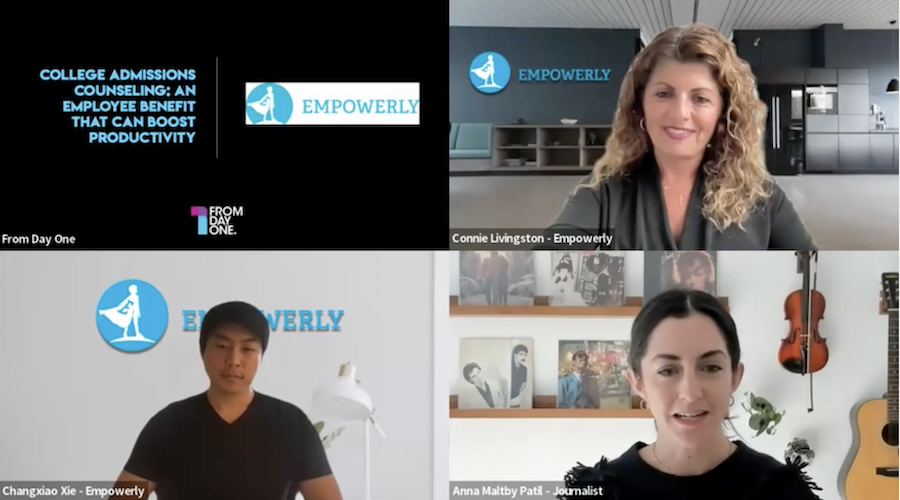College Admissions Counseling: An Employee Benefit That Can Boost Productivity


Three years ago, Connie Livingston’s teenage son was going through the college admissions process. Livingston, who had been an assistant director of admissions at Brown University for 14 years, was shocked to learn first-hand just how stressful the process is for students and their families.
“I thought, ‘Wow, I could really help them by taking this burden off their plates,’” she told journalist Anna Maltby Patil in a From Day One Webinar about College Admissions Counseling: An Employee Benefit That Can Boost Productivity.
So Livingston, who is now the head of counselors, joined Empowerly. The platform connects students worldwide with experts who have a deep understanding of the U.S. college admissions process. Empowerly’s clients include not just individual students and their families, but also an increasing number of companies, both big and small. These employers recognize that offering college admissions counseling to their team members boosts worker satisfaction, which has fallen to its lowest level in two decades.
The Challenge of Getting Into College Today
Over the past couple of years, students and families have been spending more than 200 hours working on college applications because the process has become more complex, according to Changxiao Xie, co-founder of Empowerly. And that’s just the tip of the iceberg when it comes to the time and effort needed to prepare for higher education, he said.
Even a decade ago, college was nowhere near as expensive as it is now, says Xie. “So, you have to make sure you’re getting into the right program with the right fit for you so you’re not going to switch majors or transfer to another university and pay even more money,” he said.
Another factor putting pressure on students and families is today’s complexity around entry-level employment.
For example, students who think they might be interested in software engineering as a career need to figure that out early enough in their high school years so they can build their skills to a level where they can get internships at top companies by the time they are a freshman or sophomore in college, says Xie.

Making things even more stressful, the competition to get into college is tougher than ever. “Ten to 15 years ago, the average application volume nationally hovered anywhere from 15,000 to 20,000 applications per school per year,” Livingston said. “Now we see schools with 50,000 plus applications per year, some approaching 100,000.”
A major reason for the increase in applications is that many colleges and universities have joined the common application, which means students can apply to as many as 20 schools with one application, says Livingston. However, the number of spaces colleges have available for incoming freshmen hasn’t increased.
Due to this more selective environment, college admission officers are “Looking for students with a sense of purpose,” Livingston said. “In addition to stellar grades and testing, admission officers are looking at things like, what have you done? What have you accomplished? How have you made an impact? What is unique about you? Have you specialized in something that’s really important to you that you’re passionate about? And how can you bring that specialty to our campus?”
In addition to the difficulty of applying to and getting accepted by colleges and universities, students and parents are facing the daunting prospect of qualifying for financial aid, which is more important than ever due to the rising cost of higher education. Families must fill out the Free Application for Federal Student Aid (FAFSA). The application process normally opens in October, but a revamped FAFSA will now roll out sometime in December.
Empowerly offers not only college admission counseling services, but also assistance with FAFSA and even helps find non-federal scholarship and grant opportunities.
Why Companies Offer College Admissions Counseling
College admissions services might seem like an extravagant benefit to offer employees in an era where companies are tightening their belts, but many businesses say the investment is worth it, says Xie.
Whether the economy is good or bad, “people still have kids, and kids will always have to go to college, or at least figure out what they want to do,” he said.
And when those employees take advantage of the college admissions counseling their company offers, “this is something that just immediately boosts productivity” because the workers are less stressed by something they are going through in their personal lives, says Xie.
“We don’t see this as a one and done benefit that maybe you don’t get much ROI on,” he said. “It’s an investment into the employees’ future, because it’s an investment into their kids’ future.”
Editor's note: From Day One thanks our partner, Empowerly, for sponsoring this webinar.
Mary Pieper is a freelance reporter based in Mason City, Iowa.
The From Day One Newsletter is a monthly roundup of articles, features, and editorials on innovative ways for companies to forge stronger relationships with their employees, customers, and communities.